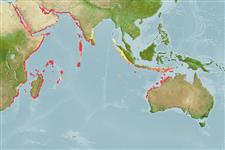>
Acropomatiformes (Oceanic basses) >
Pempheridae (Sweepers)
Etymology: Pempheris: Greek, pempheris = the name of a fish (Ref. 45335); tominagai: Named for the Japanese ichthyologist Yoshiaki Tominaga, who contributed to taxonomy and morphology of Pempheridae..
Environment: milieu / climate zone / depth range / distribution range
Ecologia
marino; distribuzione batimetrica 1 - 10 m (Ref. 95675). Subtropical
Indian Ocean: widely distributed in the Red Sea and the Indian Ocean, including NW coast of Australia. Not found in the coasts and islands of Indonesia and NE Australia, and Andaman Sea. Allopatric with sister species Pempheris schwenkii which is widely distributed in the Pacific Ocean.
Size / Peso / Age
Maturity: Lm ? range ? - ? cm
Max length : 11.7 cm SL maschio/sesso non determinato; (Ref. 95675)
Life cycle and mating behavior
Maturities | Riproduzione | Spawnings | Egg(s) | Fecundities | Larve
Koeda, K., T. Yoshino, H. Imai and K. Tachinara, 2014. A review of the genus Pempheris (Perciformes, Pempheridae) of the Red Sea, with description of a new species. Zootaxa 3793(3):301-330. (Ref. 95675)
IUCN Red List Status (Ref. 130435)
Threat to humans
Harmless
Human uses
Strumenti
Special reports
Download XML
Fonti Internet
Estimates based on models
Preferred temperature (Ref.
123201): 24.6 - 29.1, mean 27.5 °C (based on 804 cells).
Phylogenetic diversity index (Ref.
82804): PD
50 = 0.5000 [Uniqueness, from 0.5 = low to 2.0 = high].
Bayesian length-weight: a=0.01288 (0.00539 - 0.03078), b=3.03 (2.84 - 3.22), in cm total length, based on LWR estimates for this Genus-body shape (Ref.
93245).
Trophic level (Ref.
69278): 3.4 ±0.5 se; based on size and trophs of closest relatives
Resilienza (Ref.
120179): Alto, tempo minimo di raddoppiamento della popolazione meno di 15 mesi (Preliminary K or Fecundity.).
Fishing Vulnerability (Ref.
59153): Low vulnerability (10 of 100).
